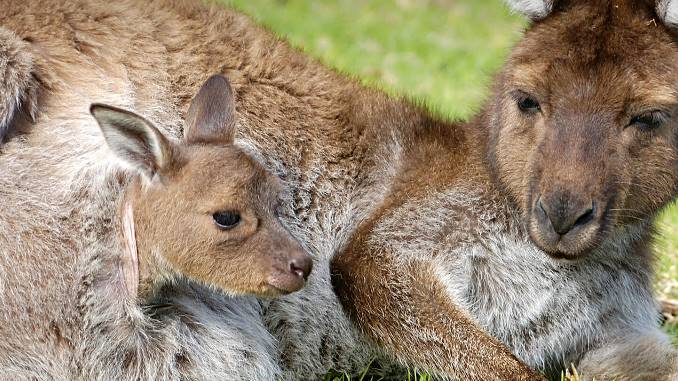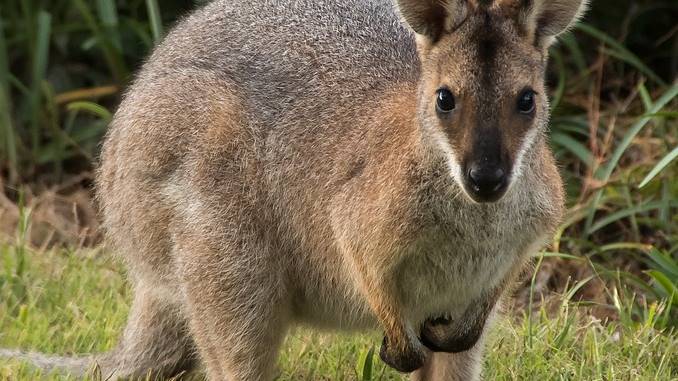Disclaimer: The information presented below is for general informational & educational purposes only. Always consult with animal professionals in case of specific concerns.
Ask anyone about an animal with a pocket that they know, and most will say ‘a kangaroo.’ The popular marsupial is the kangaroo, primarily present in Australia.
However, the marsupial world has many other fascinating species waiting for you to discover, such as koalas or wallabies.
Today’s post will get a peek inside 12 animals with pouches, including the famous kangaroo and popular marsupial animals.
List of 12 Animals With Pouches
Can’t wait to dive into the fantastic world of creatures with a special ‘accessory’? So can’t we. Here are the most popular marsupials in the world.
Kangaroo

Kangaroos are dangerous animals that are common in New Guinea, Victoria, Western Australia, and Tasmania. You can easily detect the animal’s pouch due to its upward-facing and sizable openings.
This part is essential for protecting and nourishing Joey – a kangaroo’s newborn whose length is about one inch at birth. The pouch basically provides Joey with everything for growing.
The inner surface is hairless, containing teats that produce plenty of milk to bring Joey up.
Besides, the sweat glands lining the pocket can generate an antimicrobial element that keeps the baby germ-free and safe.
The mother frequently cleans this container by putting the head into it and licking Joey’s excretion.
Dasyuridae
We can find numerous marsupial characteristics in the Dasyuridae since it includes seven different marsupial carnivore species, such as the Tasmanian devil and quolls.
People can find these creatures in coastal regions of New Guinea and Australia. Dasyurids are cruel predators, occasionally showing aggressive behaviors.
They eat insects every day, while larger ones hunt tiny birds and mammals, including livestock.
Wombat
As a member of the Vombatidae family, wombats are present in central Queensland, Tasmania, Australia, and other regions.
Since they’re marsupials, wombats have backward-facing pockets on their bodies which help get rid of dirt when digging.
The most important role that the pouch is responsible for is protecting and nourishing the infant wombats called Joey.
The newborn crawls toward the pouch, where it will nurse, grow, and develop in seven to ten months.
Wallaby

There are various species of wallabies, such as rock, brush, and shrub wallabies. Yet, none of them make good pets.
This marsupial belongs to the Macropodidae family, Order Diprotodontia. Its most common habitats are in the UK, Hawaii, New Zealand, and Australia.
A marsupium is a safe place for tiny newborns to crawl into since they’re helpless and fragile after birth.
There’s safety from germs and microbes and teats for nutrients and nourishments in the mother’s upward-facing pocket. The baby wallaby will stay there and grow until it’s strong enough to feed itself.
Seahorse
Like wallabies, seahorses come in various species, including big-belly, zebra, dwarf seahorse, and others.
These small marine creatures belong to the Syngnathidae family, Genus Hippocampus, commonly found in estuaries, seagrass beds, mangroves, and coral reefs.
The strange thing is that male seahorses carry pockets called brood pouches on their belly.
Female seahorses will transfer hundreds of eggs to the brood pouches of their partners through the ovipositors. During this period, the female becomes slimmer while the male becomes bulged.
Brood pouches can contain thousands of seahorse eggs, which will hatch in about nine to 45 days.
Koala

Do koalas have pouches? Yes. Koalas are a marsupial belonging to the Phascolarctidae family, Genus Phascolarctos.
You can encounter them climbing trees and living in Eastern and Southeastern Australia’s eucalyptus forests.
What makes koalas stand out from other marsupials is the downward-facing pocket. The powerful sphincter muscle at the top will prevent the baby’s falling.
Another dissimilarity between koalas and other species is that the mother won’t clean the pocket. Underdeveloped Joeys can find two teats inside for feeding.
After birth, an offspring typically weighs around 0.5 grams – too light and vulnerable to survive alone.
A special thing about a koala’s Joey is that it consumes the pap during development – a fecal form containing bacteria crucial for digesting eucalyptus.
Ringtail Possum
The last animal to end this gripping list is the ringtail possum. If you want to watch it in real life, you can travel to Eastern and Western Australia.
Like other species of Joey, young ringtail possums will crawl into the female’s pocket for nourishment. Once the body goes through initial changes, one will open its eyes.
This time, the mother will start feeding more solid foods rich in lipids and protein for healthy, thriving development, making the young ones strong enough to go outside.
American Opossums
Since Virginia opossums are native to America, people often call them American opossums. Apart from the US, we can see these marsupials in North Mexico and other regions.
A baby Virginia opossum is too tiny (similar to a honeybee’s size) to live alone under harsh weather; it needs the mother’s pouch to grow safely and healthily.
With 13 teats inside the pocket, the Joey can comfortably feed milk for about two months – a typical pouch lifetime of a newborn opossum.
When this period ends, it will learn survival and self-protection skills on the mother’s back. Later, it will live independently and start finding food itself.
Sugar Glider
A less common animal among wildlife explorers is the sugar glider. Those nocturnal gliding possums are present primarily in Papua New Guinea, Indonesia, and Australia.
Surprisingly, a female sugar glider usually requires only 15-17 days to finish the gestation process.
After that, the tiny Joey weighing about 0.3 grams, will crawl into the mother’s pocket for protection and nourishment.
There are two to four nipples, a septum, and an exocrine gland inside the pocket that protects the baby from falling forces.
What impressed us the most when researching this creature was the ability to glide through the air. Notably, females do that when carrying the babies inside the pouches. Isn’t it extraordinary?
Horned Marsupial Frog
Horned marsupial frogs appear mostly in Panama, Ecuador, Costa Rica, and Columbia. These arboreal frogs belong to the Hemiphractidae family, Genus Gastrotheca.
This family is well-known for the biggest amphibian eggs that don’t even go through the tadpole or large stages.
Female horned frogs have specialized pockets called brood pouches.
They feature unique skin that is exceedingly permeable to water and gas exchange and vascular, meant to protect, nourish, and store the growing eggs.
Tasmanian Devil

Tasmanian devils are the most sizable predatory species in the marsupial class that don’t make great pets. They are usually found in Australia, Wales, and Tasmania island states.
Like any marsupial, Tasmanian devils have pockets on their bodies, which uncommonly face the backward direction. This characteristic comes for good reasons, particularly keeping dirt from the pockets.
There are four teats inside a female’s pouch, meaning that one can carry four devil infants maximum. A Joey typically weighs about 0.2 grams, so you can imagine how tiny it is at birth.
It will require nine months to start developing faster and becoming independent.
Wallaroos
People call common wallaroos by many names, like hill wallaroo, euro, or simply wallaroo. This marsupial macropod inhabits various regions worldwide, such as Queensland, Victoria, Australia, etc.
The females were born with pockets and can produce Joey in 35 days, who will crawl into the mother’s pocket for safe nourishment and growth.
A baby wallaroo typically needs 6-9 months in the pouch to be ready for an independent life.
Interestingly, the parent wallaroos will live and care for the baby together until it can survive alone. But after that, they will split apart.
Males grow faster than females, requiring 18-20 months for the entire development, while females require 14-24 months.
Read more: Animals With Webbed Feet (17 Amazing Species With Pics)
Why Do Marsupials Have Pouches?
Pouches play a critical role in the reproduction process since marsupials don’t have a long gestation period like other mammals.
After birth, their infants are extremely tiny, crawling into the pocket to continue breathing and developing.
For example, a female opossum gives birth to 6-20 offspring, and these newborns are furless, blind, deaf, and only have two working limbs.
The time lying in their mom’s fur-lined pocket is imperative for their survival and development. Yet, some newborns even die before making it to the pocket.
Marsupials like kangaroos use the pouches to carry and nurture their babies, allowing them to feed while still mobile.
Are Monkeys Marsupials?
Common monkeys are not marsupials, but cuscus – an Australian mammal – has a pouch on its body. It is one of the seven species belonging to the Phalanger family.
These monkeys’ average length is 12-25 inches (30-65 cm), with the tail being 10-24 inches (25-60cm).
Is A Platypus A Marsupial?
No, it isn’t. Platypuses and their closest relatives, echidnas, are mammals belonging to the Monotremata group.
They are the last representatives still alive of this family, living among marsupials from New Guinea, Tasmania, and Australia.
Are Dolphins Marsupials?
Like platypuses, dolphins are placental mammals, not marsupials. While animals with pockets give birth during the early stage of fetuses, this process occurs after fetuses for placental mammals.
Today, some prominent placental mammal species are whales, dolphins, seals, bats, rodents, hoofed animals, bears, dogs, cats, and primates.
Are Sloths Marsupials?
No, sloths are not creatures with pockets or primates; they’re mammals – though these three groups share some features in common.
For example, koalas and sloths are not dangerous animals that inhabit trees, have a pretty slow metabolism, and eat leaves.
The Bottom Line
Nature always has reasons for its work and does not create marsupials with useless pockets.
These special parts prove to be a safe environment for fetuses to develop fully, providing a protective and healthy place for the young’s maturation.
If you’re like us, you’re always eager to learn about the limitless, fascinating wildlife. We hope that this list of 12 animals with pouches has made your day.

Hi, my name is John, and I’m an animal lover. I’ve been fascinated with the animal kingdom since I was 5 years old, and my passion keeps growing bigger as I age. And this blog is where I share my researches and passion with animal lovers all around the world.
